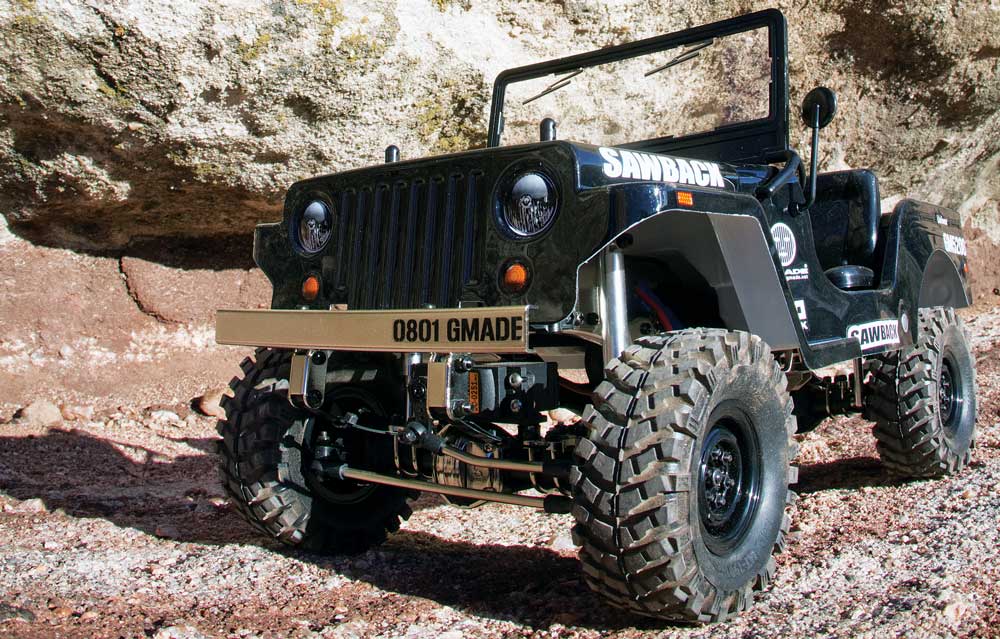
Words: Ty Giebel
Photos: Ty Giebel
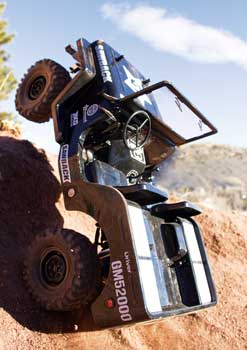
The Gmade Sawback follows the styling of an early Willy’s Jeep. The simple open cockpit gives the vehicle an open feel with a design that dates back to before safety was a primary concern in motor vehicles. Before the Sawback, the only option we had for modelling a Willy’s Jeep was the laborious task of modifying a 1/6-scale toy. Now Gmade has taken this difficult task and made it simple for the masses to be part of. Get ready to relive those WWII test videos in your own backyard!
AT A GLANCE
WHO MAKES IT: Gmade
WHO IT’S FOR: Scale Enthusiasts/Trail Runners
PART NO.: GM52000
HOW MUCH: $269.99
BUILD TYPE: Kit
PROS
• One-piece composite axle housings
• Dust proof receiver box
• Scale appearance
• Beadlock wheels
• 3-dimensional scale interior
• Metal differential covers
CONS
• Suspension is very stiff
• Tires are hard
AUTHOR’S OPINION
The Sawback is a step in the right direction for Gmade. The scale drivetrain and appearance have fantastic scale details. While the Sawback has a few shortcomings, the overall vehicle makes up for them, with a platform that allows customization throughout. The realistic axles and suspension give this vehicle a look and feel that is hard to match.
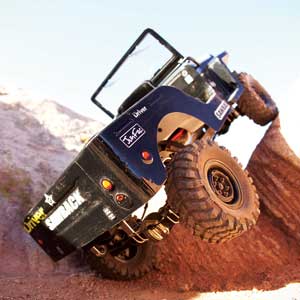
FACTS
• The GS01 ladder frame chassis has many scale details you’ll recognize from the full-scale world. The chrome plating allows the chassis to stand out against other chassis on the market. While body hangers are mounted to the sides of the chassis to add to the scale detail, there are several holes in the chassis that allow leaf spring hangers, cross members and the skid plate to be bolted to the platform with ease.
• The suspension of the Gmade Sawback is based around leaf springs. Links are no longer needed with the leaf springs mounting in front and behind the axles. Also important to the function of the suspension are dampers with springs inside. These make the suspension that much more fi rm but for me they also present a small problem. Out of the box, the suspension is very stiff so some simple modifi cation is in order to soften it up and allow it to fl ex while on the trail. The fi nal suspension detail is a set of scale U-bolts with top plates to hold the leaf firmly on the axle.
• The steering is accomplished with a simple, but a very effective tie rod and drag link. With the servo mounting on the front axle, the steering performs effortlessly. While this is not the scalest approach it does perform very well. The placement of the steering is optimal for performance but the dog bones and cups limit the steering more than I would like. Luckily, Gmade is already on top of this and offers a CVA kit that gives you not only less slop in the drivetrain, but also more steering. The servo mount is secured to the axle with two screws that mount firmly to the top of the axle housing. Even the axle housing itself has a fl at spot molded into it to provide a perfect mounting location for the leaf springs.
• The drivetrain performed flawlessly on the trail, without a single stutter or snag in the system. The centrally mounted transmission provided equal power to both locked differential axles without fault. Although while on steep descents I could hear some backlash in the system, there was still never a moment of alarm when driving up or down any obstacle. The plastic drivelines coming off the central transmission are some of the stoutest I have seen out of a kit, allowing them to go the distance.
• The body is made from clear Lexan. Detailing the body are several ABS plastic parts, including a steering wheel, windshield bracket, shift lever, mirror and seats. Completing the details of the Sawback are several decals that outline the interior gauges and outside lights. The body mounts fi rmly against the front bumper with four body posts, two in the front and two in the bed of the Jeep body.
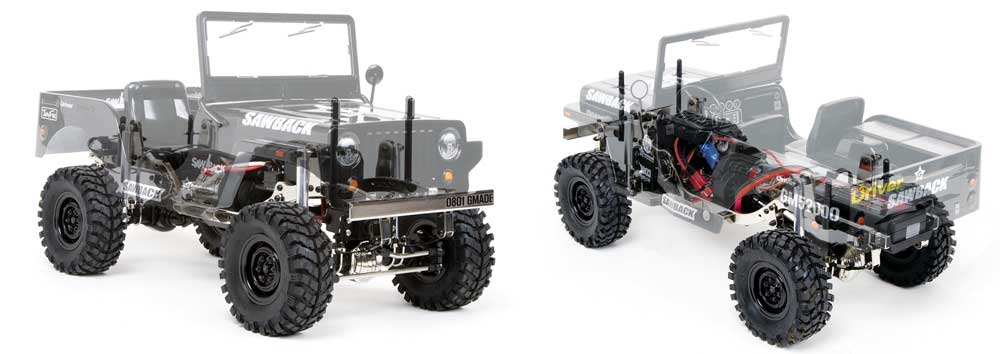
TOOLS AND ACCESSORIES INCLUDED
• 4-way wrench
• L wrenches
ITEMS NEEDED
• Motor
• Electronic Speed Control
• Steering servo
• Transmitter/receiver
• BEC
ITEMS USED
• Tekin FXR ESC. The Tekin FXR is a tried and true ESC for RC rock crawling. The small platform and hotlink programming allow this ESC to be easily programmed and jammed into a tight location within the vehicle. With drag brake, LiPo cut-off and forward to reverse programming being the top items of adjustment, it’s no wonder this is one of the top speed controllers in the rock crawling world.
• Tekin 35-turn brushed motor. For years there have been two choices for motors; brushed and brushless, but these Tekin 35-turn motors are just what the doctor ordered for the Sawback. The smooth startup and large power band make it easy to go from a slow crawl to a full throttle assault. The machine-wound armature and great price point gave me little worry when it came time to kick up dirt or splash through the odd puddle.
• Futaba R2106GF receiver. This has performed its task flawlessly over the years and the inexpensive price and small footprint make this an ideal receiver for those tight spaces. This 6-channel receiver with the FHSS system allows extra ports to power lights, winches, etc., through the receiver to keep wiring neat and simple. The simple push button binding to the Futaba 4PL transmitter is a breeze and provides a nice alternative to the larger R2104GF receiver the 4PL comes with.
• Savox SC-0251 MG servo. While no one may have heard of this company a few years ago they are fast making a name for themselves as not only the most affordable servos on the market but some of the fastest and strongest out there. At roughly $40, this servo pushes over 220 ounces of torque at .18 transit speed. For the price it doesn’t get any better.
• Castle Creations BEC. This is a staple of RC crawling. Without an external BEC the speed controller can “brown out,” causing all the electronics to shut down. The CC BEC takes on the task of powering the receiver and servo only, while the ESC is allowed the single task of powering the motor. This designation of power allows the electronics to work more efficiently without over-taxing the FXR speed controller’s internal BEC.
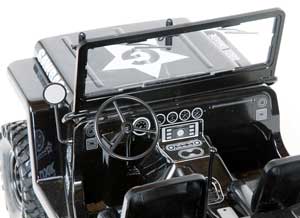
HOP-UPS WE RECOMMEND
• GS01 Front drive CVA kit, GM52109S. A nice addition to remove slop and add a tighter turning radius.
• Aluminum one-piece Knuckle arm, GM51105S. Adds durability to the steering, allowing the truck to take more abuse.
ON THE TRAIL
The maiden voyage of the Gmade Sawback was a trial run with the Racers Edge 3-cell 3400mAh battery. I knew it could handle a couple of hours on the trail and it was time to put it all to the test. From the moment I parked the car the Sawback was on the ground and running, fi rst down a simple single track hiking trail which quickly grew more difficult as it climbed up a rock face. With a blip of the throttle it was easy to climb up the face into a loose scurry field of rock on top. When it came time to articulate through the rock fi eld the suspension floated over it. The leaf sprung suspension requires some break-in to allow it to fl ex more freely. Coming from a background of driving several leaf sprung trucks I was expecting this, but the Sawback was even stiffer than anything I had previously experienced. Even so there are several ways to soften the leaf springs to allow them to move and fl ex much better on the trail. Removing part of the sides of the eyelets allows the leaf springs to move on the hangers more freely so the suspension can work that much better. Another trick is to remove the springs from the dampers mounted on the chassis. With these simple modifications the suspension becomes soft enough to articulate through trickier locations.
Back to the trail! After floating through the rock field we were back on a single track trail heading to some loose sandstone. Fighting for traction is a common occurrence at this location and the stiff tires of the Sawback pulled the rock apart, allowing the fight for traction to continue. The Sawback, though, is not focused around hardcore rock crawling, which I soon realized while out on the trail. After this epiphany I changed the tempo of the drive, searching out loose dirt and sticking more to the trail to conquer those small rocks that popped up all too often. To me the stock Sawback has two downfalls, the tires and the stiff suspension, but both can easily be remedied by modifying the suspension and replacing the tires. While this may seem like a downer it really is not. In fact, it is a pretty common practice in RC crawling. While these two things really dictate the performance of the vehicle they are also some of the easiest things to fix.
After a few hours on the trail I knew the battery was beginning to diminish, so I stopped climbing deeper into the trees and started back down the trail. The descent was a breeze for this vehicle. With the battery in the back it proved to be very balanced going down. While hardcore rock crawlers often bias their weight to the front to provide better climbing, the Sawback is more evenly balanced and proved itself to be a vehicle that is suited for long trail runs with the helping hand of a winch on those steep climbs. For me the trail run elicited mixed reviews. I went out thinking I had a hardcore rock crawler in my hands but I was mistaken. The Sawback shines as a trail runner, suited for long trail runs through the dirt, mud, snow and the odd rock that needs tackling.
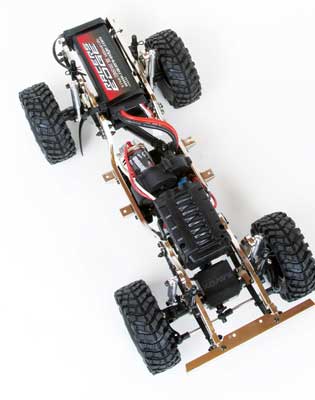
SPECS & TUNING OPTIONS
DIMENSIONS
LENGTH: 17.4-in. (442mm)
WIDTH: 8.58-in. (218mm)
AXLE WIDTH: 7.2-in. (183mm)
WHEELBASE: 11.3-in. (287mm)
GROUND CLEARANCE: 2.36-in. (60mm)
WEIGHT: 3.75lbs. (1.7kg) (no electronics)
BODY, WHEELS AND TIRES
BODY: Clear
WHEELS: 1.9-in. beadlock wheel
WHEEL ADAPTER TYPE: 12mm hex
TIRES: All terrain, MT-1901
TIRE HEIGHT: 4.2-in. (105mm)
TIRE WIDTH: 1.5.-in (38mm)
SUSPENSION
TYPE: Leaf sprung solid axle
SHOCK POSITIONS: Non adjustable
CAMBER: Non adjustable
ROLL: Non adjustable
WHEELBASE: Non adjustable
RIDE HEIGHT: Non adjustable
MISC: None
STEERING
TYPE: Tie rod and drag link
TOE: Non adjustable
CHASSIS
TYPE: Ladder frame
MATERIAL: Steel
THICKNESS: N/A
DRIVETRAIN
TYPE: 4WD
TRANSMISSION: Center mounted
DIFFERENTIAL: Ring and pinion
CLUTCH TYPE: N/A
GEAR RATIO: Optional pinion gears
BEARINGS: Full ball bearings

WRAP UP
I come from a background of running rally cars that tackle tight, twisty corners and hardcore rock crawlers that climb obstacles I can barely walk up. I came in expecting the Sawback to climb vertical walls and fl ex through the roughest terrain, but I was off base. The Sawback is not a hardcore rock crawler; in fact it is something even more fun, leading the pack through hours of trail riding, driving down the trail with your friends in tow, following the trail and taking the odd shortcut to find something challenging to maneuver over is the Sawback’s M.O. Hitting little jumps and sliding around corners, the Sawback had no problem putt ing a smile on my face while I got out, enjoyed the weather and took in the sights along the trail. Once I took my dog for walks on these trails, but no longer. I have a new dog and its name is Sawback.
LINKS
Castle Creations, castlecreations.com, 913-390-6939
Futaba, futaba-rc.com, 217-398-8970
Gmade, gmadeusa.com
Racers Edge, racers-edge.com, 866-855-5566
Savox, savoxusa.com, 1-800-622-7223
Tekin, teamtekin.com, 208-634-5559
 RC Driver The Best In RC Car & Truck News, Reviews & Video
RC Driver The Best In RC Car & Truck News, Reviews & Video






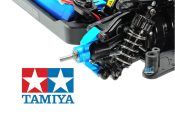


Our next RC will be a sawback sport. I was going to get the one you wrote about but the sport looks more like our CJ-5. We are getting it because of your Good review, It is well written.